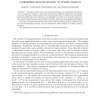Free Online Productivity Tools
i2Speak
i2Symbol
i2OCR
iTex2Img
iWeb2Print
iWeb2Shot
i2Type
iPdf2Split
iPdf2Merge
i2Bopomofo
i2Arabic
i2Style
i2Image
i2PDF
iLatex2Rtf
Sci2ools
SIAMIS
2010
2010
Compressed Remote Sensing of Sparse Objects
Abstract. The linear inverse source and scattering problems are studied from the perspective of compressed sensing, in particular the idea that sufficient incoherence and sparsity guarantee uniqueness of the solution. By introducing the sensor as well as target ensembles, the maximum number of recoverable targets (MNRT) is proved to be at least proportional to the number of measurement data modulo a log-square factor with overwhelming probability. Important contributions include the discoveries of the threshold aperture, consistent with the classical Rayleigh criterion, and the decoherence effect induced by random antenna locations. The prediction of theorems are confirmed by numerical simulations.
Classical Rayleigh Criterion | Linear Inverse Source | SIAMIS 2010 | Sparsity Guarantee Uniqueness |
| Added | 21 May 2011 |
| Updated | 21 May 2011 |
| Type | Journal |
| Year | 2010 |
| Where | SIAMIS |
| Authors | Albert Fannjiang, Thomas Strohmer, Pengchong Yan |
Comments (0)

